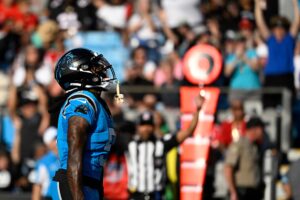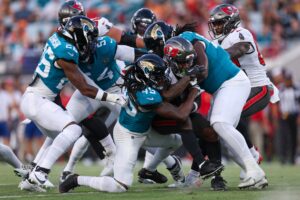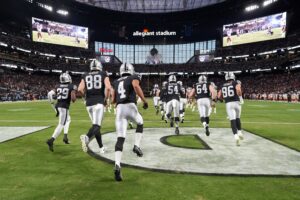After the first two games of the season, the Seattle Seahawks performance has yielded mixed results. The good news is the defense is even better than expected. The bad news is the offensive line is worse than advertised. Fortunately, there are measures that may help to solve Seattle’s offensive problems.
Repairing The Broken Seattle Seahawks Offense
In addition to star quarterback Russell Wilson, Seattle already possesses some of the most talented receivers, tight ends and running backs in the game. Their only serious problem is their inexperienced offensive line.
In the first game against the Green Bay Packers, Seattle attempted to run the ball seemingly every play. Head coach Pete Carroll wisely deduced this approach would not work, and began attempting more passes in week two against the San Francisco 49ers.
This plan proved more effective. Even though the Seahawks still did not score many points, they gained more yardage and advanced the ball downfield effectively. Although San Francisco’s defense did not pose much of a challenge, Seattle’s game plan was still a step in the right direction. The following are steps that should help improve Seattle’s struggling offense.
Use Fullbacks And Tight Ends To Help Block
When the offensive line is having difficulties, the initial reaction is to attempt to sign stronger linemen. At this point in the season, however, the roster is usually cemented with little room for additions. The free agent market contains virtually no attractive prospects. Trading current players for starting linemen is no longer an option. Seattle has already inexplicably released promising wide receiver Kasen Williams. They also traded wide receiver Jermaine Kearse and a second round draft pick for defensive tackle Sheldon Richardson.
These were not good decisions for the Seahawks. For two excellent receivers and a second round draft pick, the team could have acquired several linemen and potentially solved their offensive line woes. Seattle now must make the best use of the players they have.
The simplest solution to this problem is to use extra players to help block. Rather than using their tight ends like wide receivers, they can use them to provide pass protection. Most offenses commonly use tight ends in this way anyway, and rarely use them to catch passes. In addition to run blocking, fullback Tre Madden could also help with pass protection. Perhaps the Seahawks line is struggling not only from having youthful players, but also from insufficient manpower.
Call Plays That Require Fewer Skill Position Players
Of course, the extra pass blockers must come from somewhere. An empty backfield will free up players to assist with pass protection. Play action passes require running backs that primarily serve as decoys, but have little direct impact on the play. The quarterback fakes a handoff in order to deceive defenses into believing they are running the ball. This element of surprise can prove beneficial, but defenses often do not fall for the trap. The extra players required for this type of play are more useful helping to protect the quarterback.
Calling plays that require fewer receivers will also free up players to bolster the offensive line. Multiple receiver sets often serve to create confusion even though the extra receivers are not realistic targets for reception. Recognizing the weakness of Seattle’s line, opposing defenses are frequently blitzing. Using extra blockers will keep opposing defenses honest, forcing teams to send linebackers back into coverage. These adjustments will give Wilson more time to make accurate passes and receivers more time to run their routes.
Foster A More Aggressive Approach To Pass Protection
Rather than playing to win, Seattle’s offensive linemen often look like they are playing not to lose. The players appear tentative and confused. Instead of charging ahead, they step back for fear of missing assignments. Coaching players to aggressively surge forward should produce stronger line play.
Seattle’s linemen may not be the strongest and fastest in the league, but better conditioning should also help. Many coaches often prefer so called “butt and gut” linemen that dominate through sheer size and brawn. Encouraging a more aggressive mentality may help improve player confidence.
The Seahawks have several winnable games in the weeks ahead. While these games will not be easy, their upcoming opponents, including the Tennessee Titans, Indianapolis Colts and Los Angeles Rams have historically struggled. With a little extra help on the offensive line, hopefully the Seahawks will be able to make the most of these opportunities.






